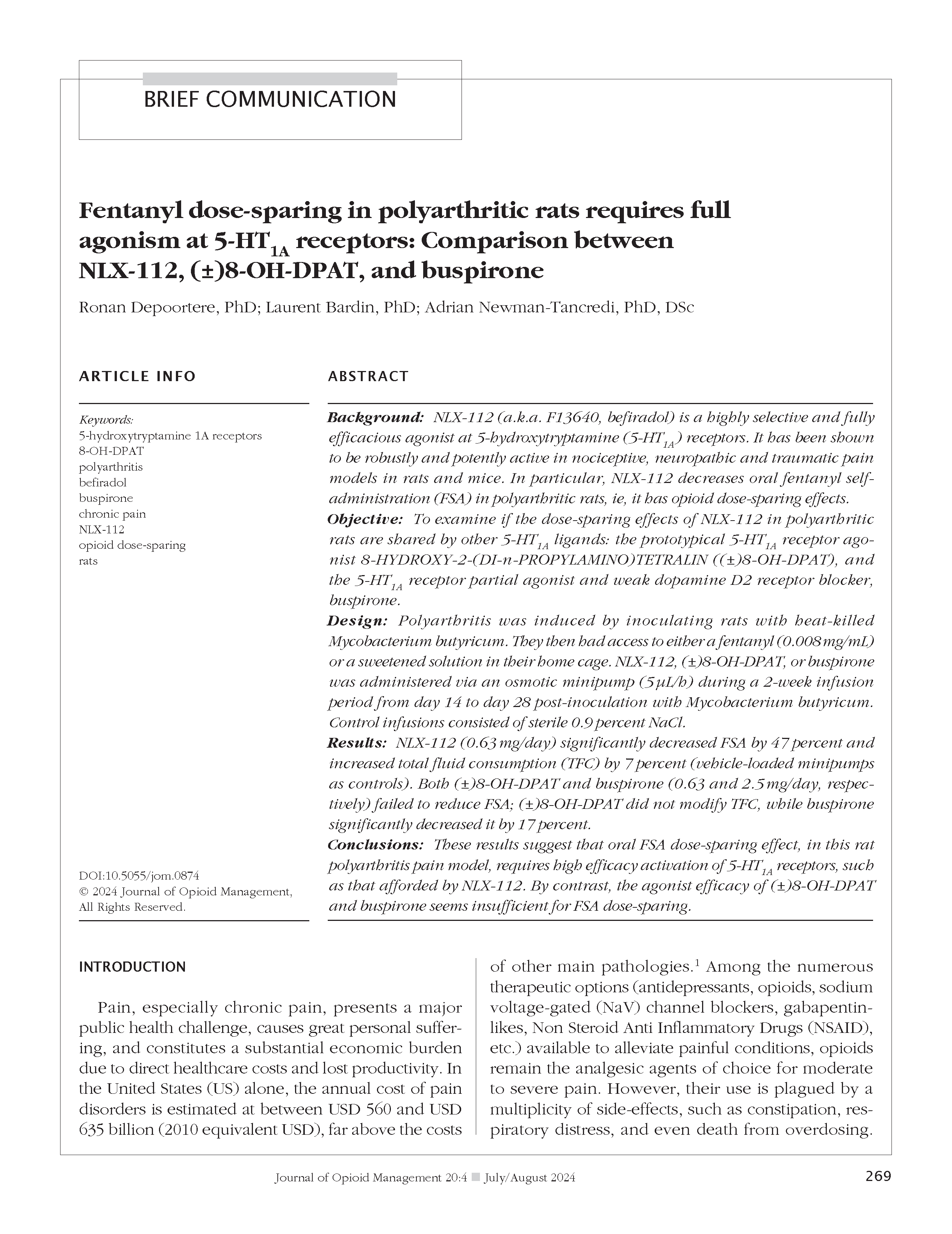Fentanyl dose-sparing in polyarthritic rats requires full agonism at 5-HT1A receptors: Comparison between NLX-112, (±)8-OH-DPAT, and buspirone
DOI:
https://doi.org/10.5055/jom.0874Keywords:
5-hydroxytryptamine 1A receptors, 8-OH-DPAT, polyarthritis, befiradol, buspirone, chronic pain, NLX-112, opioid dose-sparing, ratsAbstract
Background: NLX-112 (a.k.a. F13640, befiradol) is a highly selective and fully efficacious agonist at 5-hydroxytryptamine (5-HT1A) receptors. It has been shown to be robustly and potently active in nociceptive, neuropathic and traumatic pain models in rats and mice. In particular, NLX-112 decreases oral fentanyl self-administration (FSA) in polyarthritic rats, ie, it has opioid dose-sparing effects.
Objective: To examine if the dose-sparing effects of NLX-112 in polyarthritic rats are shared by other 5-HT1A ligands: the prototypical 5-HT1A receptor agonist 8-HYDROXY-2-(DI-n-PROPYLAMINO)TETRALIN ((±)8-OH-DPAT), and the 5-HT1A receptor partial agonist and weak dopamine D2 receptor blocker, buspirone.
Design: Polyarthritis was induced by inoculating rats with heat-killed Mycobacterium butyricum. They then had access to either a fentanyl (0.008 mg/mL) or a sweetened solution in their home cage. NLX-112, (±)8-OH-DPAT, or buspirone was administered via an osmotic minipump (5 μL/h) during a 2-week infusion period from day 14 to day 28 post-inoculation with Mycobacterium butyricum. Control infusions consisted of sterile 0.9 percent NaCl.
Results: NLX-112 (0.63 mg/day) significantly decreased FSA by 47 percent and increased total fluid consumption (TFC) by 7 percent (vehicle-loaded minipumps as controls). Both (±)8-OH-DPAT and buspirone (0.63 and 2.5 mg/day, respectively) failed to reduce FSA; (±)8-OH-DPAT did not modify TFC, while buspirone significantly decreased it by 17 percent.
Conclusions: These results suggest that oral FSA dose-sparing effect, in this rat polyarthritis pain model, requires high efficacy activation of 5-HT1A receptors, such as that afforded by NLX-112. By contrast, the agonist efficacy of (±)8-OH-DPAT and buspirone seems insufficient for FSA dose-sparing.
References
Gaskin DJ, Richard P: The economic costs of pain in the United States. J Pain. 2012; 13: 715-724. DOI: https://doi.org/10.1016/j.jpain.2012.03.009
Newman-Tancredi A, Depoortere RY, Kleven MS, et al.: Translating biased agonists from molecules to medications: Serotonin 5-HT1A receptor functional selectivity for CNS disorders. Pharmacol Ther. 2022; 229: 107937. DOI: https://doi.org/10.1016/j.pharmthera.2021.107937
Colpaert FC, Tarayre JP, Koek W, et al.: Large-amplitude 5-HT1A receptor activation: A new mechanism of profound, central analgesia. Neuropharmacology. 2002; 43: 945-958. DOI: https://doi.org/10.1016/S0028-3908(02)00119-3
Depoortere R, Bergman J, Beardsley PM, et al.: NLX- 112, a highly selective 5-HT(1A) receptor biased agonist, does not exhibit misuse potential in male rats or macaques. Neuropharmacology. 2022; 210: 109025. DOI: https://doi.org/10.1016/j.neuropharm.2022.109025
Middlemiss DN, Fozard JR: 8-Hydroxy-2-(di-n-propylamino)-tetralin discriminates between subtypes of the 5-HT1 recognition site. Eur J Pharmacol. 1983; 90: 151-153. DOI: https://doi.org/10.1016/0014-2999(83)90230-3
Peroutka SJ: Selective interaction of novel anxiolytics with 5-hydroxytryptamine1A receptors. Biol Psychiatry. 1985; 20: 971-979. DOI: https://doi.org/10.1016/0006-3223(85)90194-5
Mason JP, Caldwell J, Dring LG: Metabolism of [propyl-3H]-8-hydroxy-2-(N,N-di-n-propylamino)tetralin in rat. Xenobiotica. 1995; 25: 71-80. DOI: https://doi.org/10.3109/00498259509061834
Colpaert FC, Tarayre JP, Alliaga M, et al.: Opiate self-administration as a measure of chronic nociceptive pain in arthritic rats. Pain. 2001; 91: 33-45. DOI: https://doi.org/10.1016/S0304-3959(00)00413-9
Rosenthale ME: A comparative study of the Lewis and Sprague Dawley rat in adjuvant arthritis. Arch Int Pharmacodyn Ther. 1970; 188: 14-22.
Colpaert FC: Evidence that adjuvant arthritis in the rat is associated with chronic pain. Pain. 1987; 28: 201-222. DOI: https://doi.org/10.1016/0304-3959(87)90117-5
Bardin L, Assie MB, Pelissou M, et al.: Dual, hyperalgesic, and analgesic effects of the high-efficacy 5-hydroxytryptamine 1A (5-HT1A) agonist F13640 [(3-chloro-4-fluoro-phenyl)-[4-fluoro-4-{[(5-methyl-pyridin-2-ylmethyl)-am ino]-methyl}piperidin-1-yl] methanone, fumaric acid salt]: Relationship with 5-HT1A receptor occupancy and kinetic parameters. J Pharmacol Exp Ther. 2005; 312: 1034-1042. DOI: https://doi.org/10.1124/jpet.104.077669
Bardin L, Tarayre JP, Malfetes N, et al.: Profound, non-opioid analgesia produced by the high-efficacy 5-HT1A agonist F13640 in the formalin model of tonic nociceptive pain. Pharmacology. 2003; 67: 182-194. DOI: https://doi.org/10.1159/000068404
Deseure K, Breand S, Colpaert FC: Curative-like analgesia in a neuropathic pain model: Parametric analysis of the dose and the duration of treatment with a high-efficacy 5-HT(1A) receptor agonist. Eur J Pharmacol. 2007; 568: 134-141. DOI: https://doi.org/10.1016/j.ejphar.2007.04.022
Deseure K, Koek W, Adriaensen H, et al.: Continuous administration of the 5-hydroxytryptamine1A agonist (3-chloro-4-fluoro-phenyl)-[4-fluoro-4-[[(5-methyl-pyridin-2-ylmethyl)-amino]-methyl]piperidin-1-yl]-methadone (F13640) attenuates allodynia-like behavior in a rat model of trigeminal neuropathic pain. J Pharmacol Exp Ther. 2003; 306: 505-514. DOI: https://doi.org/10.1124/jpet.103.050286
Deseure K, Koek W, Colpaert FC, et al.: The 5-HT(1A) receptor agonist F13640 attenuates mechanical allodynia in a rat model of trigeminal neuropathic pain. Eur J Pharmacol. 2002; 456: 51-57. DOI: https://doi.org/10.1016/S0014-2999(02)02640-7
Deseure KR, Adriaensen HF, Colpaert FC: Effects of the combined continuous administration of morphine and the high-efficacy 5-HT1A agonist, F13640 in a rat model of trigeminal neuropathic pain. Eur J Pain. 2004; 8: 547-554. DOI: https://doi.org/10.1016/j.ejpain.2004.01.002
Salat K, Kolaczkowski M, Furgala A, et al.: Antinociceptive, antiallodynic and antihyperalgesic effects of the 5-HT1A receptor selective agonist, NLX-112 in mouse models of pain. Neuropharmacology. 2017; 125: 181-188. DOI: https://doi.org/10.1016/j.neuropharm.2017.07.022
Newman-Tancredi A, Martel JC, Cosi C, et al.: Distinctive in vitro signal transduction profile of NLX-112, a potent and efficacious serotonin 5-HT1A receptor agonist. J Pharm Pharmacol. 2017; 69: 1178-1190. DOI: https://doi.org/10.1111/jphp.12762
Dourish CT: Dopaminergic involvement in the control of drinking behaviour: A brief review. Prog Neuropsychopharmacol Biol Psychiatry. 1983; 7: 487-493. DOI: https://doi.org/10.1016/0278-5846(83)90015-5
Giordano J, Rogers L: Antinociceptive effects of the novel anxiolytic buspirone in three pain tests in rats. Pain. 1989; 39: 109-113. DOI: https://doi.org/10.1016/0304-3959(89)90181-4
Bardin L, Tarayre JP, Koek W, et al.: In the formalin model of tonic nociceptive pain, 8-OH-DPAT produces 5-HT1A receptor-mediated, behaviorally specific analgesia. Eur J Pharmacol. 2001; 421: 109-114. DOI: https://doi.org/10.1016/S0014-2999(01)01029-9

Published
How to Cite
Issue
Section
License
Copyright 2005-2025, Weston Medical Publishing, LLC and Journal of Opioid Management. All Rights Reserved.










